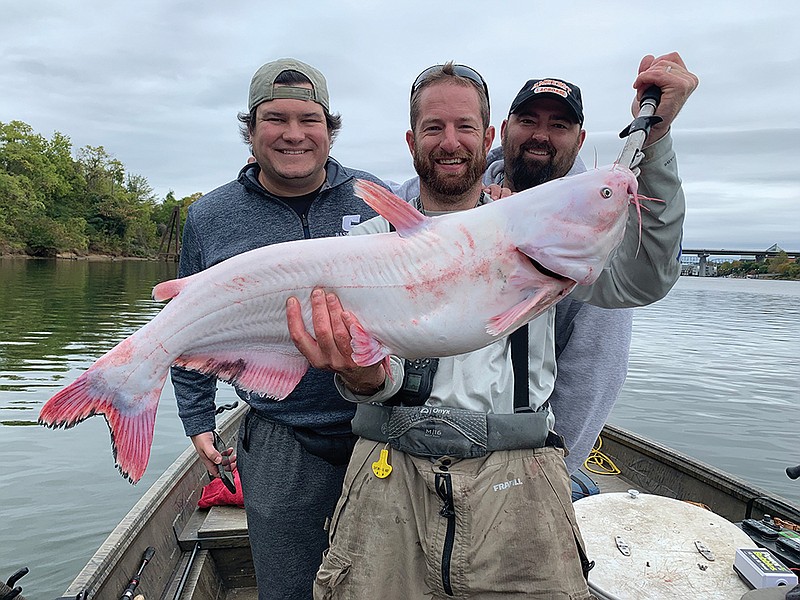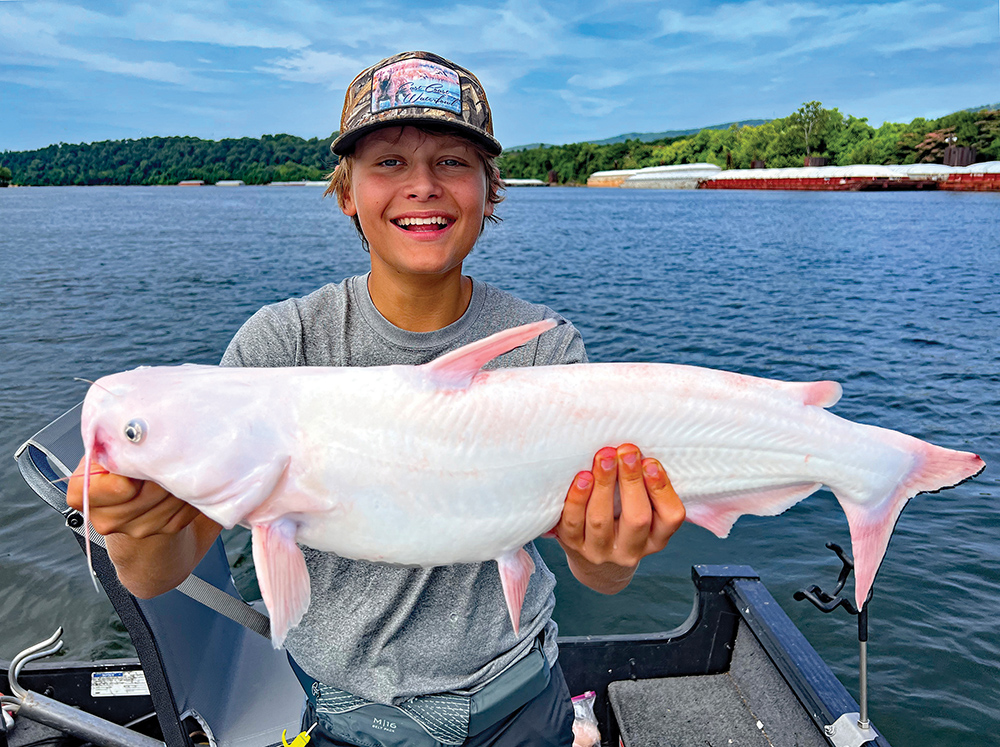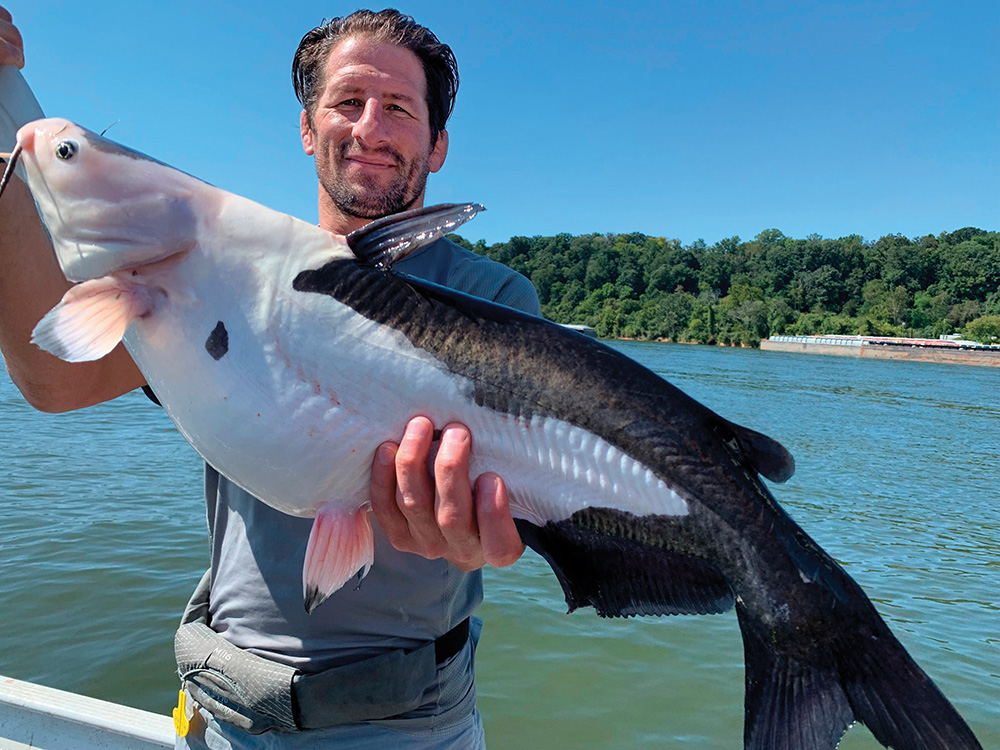On June 28, 15-year-old Edwards Tarumianz caught a gorgeous, almost pure white blue catfish on the Tennessee River near downtown Chattanooga. Captain Richard Simms, who was guiding the young angler, snapped a photo and posted it to Facebook.
The response was incredible. Within a week the photo and story were circulating worldwide on social media. National news outlets like Field & Stream, Coastal Angler Magazine, USA Today and Newsweek picked up the story.
Comments such as "one in a million" and "like winning the lottery" characterized the catch every time it was reposted. It was a very rare fish, but that's not the end of the story.
It appears the odds of hooking one of these amazing white catfish may be significantly better than "one in a million" in a particular stretch of Tennessee River downstream of Chickamauga Dam.
Simms owns Scenic City Fishing Charters, where he and two other captains specialize in guiding for catfish. Although this is the first white catfish Simms has seen on his boat in 17 years of guiding, Scenic City captains have encountered four of these peculiar fish over the past four years.
After looking back at his records, Simms estimated Scenic City captains and their guides have boated in the vicinity of 20,000 catfish since 2018. Do the math, and that equates to one in every 5,000 catfish they've caught exhibiting these odd color patterns.
Catching one remains a long shot. However, based on this anecdotal evidence, the chances of encountering a white catfish in this particular stretch of river are higher than anywhere else we've heard of.
A Little Science Lesson
Blue catfish are named blue catfish because they are typically silvery blue in color. The pale pinkish coloration of Tarumianz's fish is likely the result of leucism, which is reduced pigmentation marked by overall pale color or patches of reduced coloring. This fish had a purplish-blue tint to its head, a stark white body and pink fins. The very tip of its tail was black.
This is different from albinism, which is an absence of pigment usually characterized by white skin and pink eyes. A third color anomaly that sometimes shows up in wildlife, including fish, is piebaldism, which manifests in irregular patches of two colors.
"It is a genetics thing," said fisheries biologist Mark Thurman, when asked to dumb down genetics for a wide audience. "Things have to line up just right for these traits to show up."
Thurman is the Tennessee Wildlife Resources Agency's Region III fisheries program manager. He and his staff manage fisheries of the state's Cumberland Plateau, which includes nine major reservoirs and long stretches of the Tennessee and Cumberland rivers. Thurman said reports of white catfish from regional catfish fisheries are not common but there seems to be an uptick in the Tennessee River downstream of Chickamauga.
Thurman said Scenic City Fishing's catches seem to suggest there might be a higher than normal incidence of these white catfish in this particular stretch of river, but he stopped far short of making any sort of declaration on the subject.
"It is odd to have that many. It'd be good to know if he continues seeing them," Thurman said. "It's like any other trait that can be seen in a population. It sometimes shows up. It's a rare phenomenon and a neat thing to see out there. Sometimes nature will surprise you."
Thurman went on to say that Simms and a lot of other people put a lot of effort into targeting catfish in this section of the river, and this could play a role in how many oddly colored catfish are caught. He said these leucistic cats probably make up a very small percentage of the population.
Of the thousands of eggs deposited by a female catfish each spawning season, maybe one will have the genetic makeup to exhibit leucism. If that rare individual survived to become a fry, the young oddball would theoretically be a prime target for predation.
So, while the prevalence of color anomalies in the Chattanooga-area population is impossible to quantify, Simms is ready to go out on a little bit of a limb.
"It's become pretty clear to us that we've got a little recessive gene floating around in the river right here in the Chattanooga vicinity," Simms said. "I actually saw another one just a week or so ago. A guy, just a regular fisherman, caught a piebald. So, yeah, we've got a recessive gene floating around."
Here's how the catches went down:
The first white catfish hooked by the Scenic City crew was the one that got away. Simms said he isn't exactly sure about the timeline, but in either 2018 or 2019, Captain Sam Simons was fishing with a client when they brought a white catfish right up to the boat before it broke off. They were not able to get a photo of it, but they got a pretty good look at it, Simms said.
The next fish exhibited similar coloration to Tarumianz's fish, and it was significantly larger. Simons was not guiding a trip, he was fishing with buddies in October 2019 when he caught an estimated 15-pounder that had the same pale coloration with just a hint of black on its tail and fins.
Then, in September 2021, Captain Joe Jellison guided angler Rocco Mansueto to a blue catfish with a beautiful mixture of dark and light patches often referred to as piebald.
Simms estimated Tarumianz's June 28 fish at 28 to 30 inches in length and maybe 6 to 8 pounds. They did not take measurements because after taking photos Tarumianz was eager to release the fish quickly.
"He is a super young man," said Simms. "He was very anxious to get that fish back in the water and release it.
"Edwards may catfish for the rest of his life and never catch, or even see, another fish like that," Simms added. "I am 67 years old. I have boated literally tens of thousands of catfish over the years, and this was the first white one I'd ever seen in person."
There's no doubt these white catfish are once-in-a-lifetime catches for most anglers, and Chattanooga seems to be one of the best places to encounter one. Simms said the technique they use to catch them usually lasts into early fall most years.
Contact Scenic City Fishing Charters through their website at www.sceniccityfishing.com.
Nick Carter is the author of "Flyfisher's Guide to North Carolina & Georgia." The guide is available on Amazon.com, and autographed copies are available by emailing the author at nsc8957@gmail.com.


